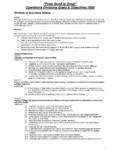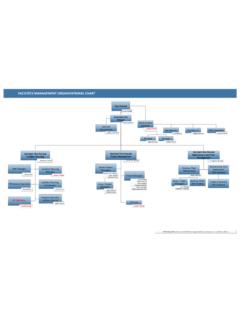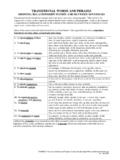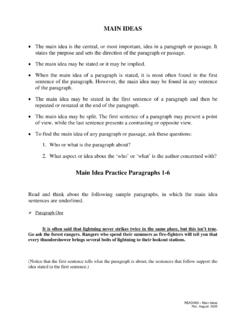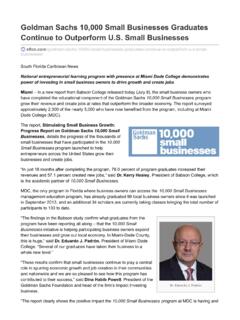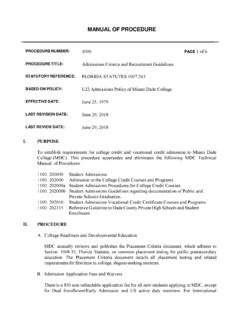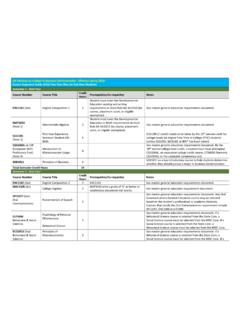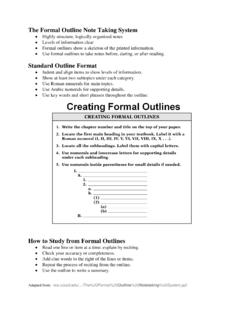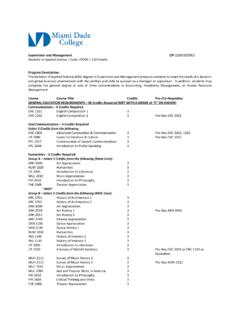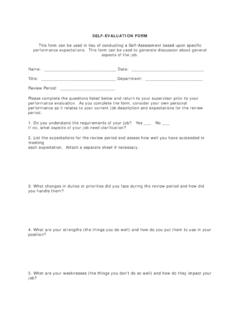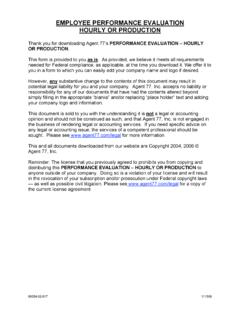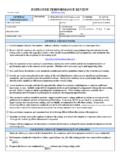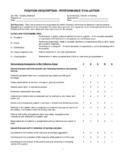Transcription of Using Rubrics to Grade, Assess, and Improve …
1 1 Using Rubrics to grade , assess , and Improve Student learning Strengthening Our Roots: Quality, Opportunity & Success Professional Development Day miami - dade college March 7, 2014 Mary J. Allen, Academic Program Assessment Assessment is an on-going process designed to monitor and Improve student learning . Faculty: develop explicit statements of what students should learn (student learning outcomes) require students to perform each outcome assess how well students performed each outcome use results to Improve student learning of each outcome (close the loop) Assessing the Evidence usually involves subjective judgments concerning complex products or behaviors Rubrics provide the criteria to guide these subjective judgments Rubrics Rubrics provide the criteria for assessing students ' work.
2 They can be used to assess virtually any product or behavior, such as essays, research reports, portfolios, works of art, recitals, oral presentations, performances, and group activities. Judgments can be self-assessments by students ; or judgments can be made by others, such as faculty, other students , fieldwork supervisors, and external reviewers. Rubrics can be used to clarify expectations to students , to provide formative feedback to students , to grade students , and/or to assess courses and programs. There are two major types of Rubrics : Holistic rubric one global, holistic score for a product or behavior Analytic rubric separate, holistic scoring of specified characteristics of a product or behavior rubric Examples Campus Examples VALUE Rubrics (Valid Assessment of learning in Undergraduate Education; AAC&U) 2 The rubric communicates what the outcome really means because it specifies the criteria for assessing its mastery.
3 Criterion-Referenced Judgments Rubrics are criterion-referenced, rather than norm-referenced. Raters ask, Did the student meet the criteria for level 4 of the rubric ? rather than How well did this student do compared to other students ? This is more compatible with cooperative and collaborative learning environments than competitive grading schemes and is essential when Using Rubrics for program assessment because you want to learn how well students have met your standards. Creating a rubric 1. Adapt an already-existing rubric . 2. Analytic Method Drafting a rubric I generally find it easier to start at the extremes when drafting the criteria in the rubric 's cells, then move up and down to draft the levels in the middle.
4 Starting at the lowest and highest cells, you ask: What are the characteristics of an unacceptable product, the worst product you could imagine, a product that results when students are very weak on the outcome being assessed? What are the characteristics of a product that would be exemplary, that would exceed your expectations, that would result when the student is an expert on the outcome being assessed? Some words I find helpful: (in)complete, (in)accurate, (un)reasonable, detailed, thorough, creative, original, subtle, sophisticated, synthesizes, integrates, analyzes, minor/major conceptual errors, flexibility, adaptability, complexity of thought, clarity, well-documented, well-supported, professional, organized, insightful, relevant 3 rubric Criteria Say you are drafting a holistic rubric to assess students ' command of basic grammar and punctuation.
5 Look at these four examples. Which do you prefer? Why? Version 1 Does Not Meet Expectations Needs ImprovementMeets Expectations Exceeds Expectations10 or more errors 5-12 errors 2-7 errors 0-1 error Version 2 Does Not Meet Expectations Needs ImprovementMeets Expectations Exceeds Expectations10 or more errors 5-9 errors 2-4 errors 0-1 error Version 3 Does Not Meet Expectations Needs ImprovementMeets Expectations Exceeds Expectationslowest 10%; more errors than 90% of the other students bottom half; more errors than the average student, but not in the bottom 10% top half; fewer errors than the average student, but not in the top 10% top 10%.
6 Fewer errors than 90% of the students Version 4 Does Not Meet Expectations Needs ImprovementMeets Expectations Exceeds Expectationserrors frequently interfere with reader's ability to understand meaning many errors or occasional errors that interfere with reader's ability to understand meaning contains a few errors, but they do not interfere with reader's ability to understand meaning virtually free of errors 4 Example: Group Collaboration rubric Outcome: students can collaborate effectively in groups. When the faculty discussed this outcome, they decided that students should be able to clearly communicate their ideas with others, show respect for others' ideas, and do their fair share of the work.
7 Group Collaboration rubric Dimension Rating Category1 below expectations 2needs improvement3meets expectations4exceeds expectations clearly communicate own ideas respect others' ideas do fair share of the work Rubrics across the Curriculum learning outcomes specify what students can do to demonstrate their learning . students master learning outcomes by practicing them repeatedly and receiving feedback to help them Improve . What would happen if your students were given feedback on the same writing rubric for every paper they wrote in your curriculum or the same speaking rubric for every presentation they made in your curriculum?
8 5 Adapting Assessment Rubrics for Grading Here s an assessment rubric an analytic rubric with three dimensions for assessing oral presentation skills. rubric for Assessing Oral Presentations Below Expectation Needs Improvement Satisfactory Exceeds Expectations Organization No apparent organization. Evidence is not used to support assertions. There is some organization, but the speaker occasionally goes off topic. Evidence used to support conclusions is weak. The presentation has a focus and provides some reasonable evidence to support conclusions.
9 The presentation is carefully organized and provides convincing evidence to support conclusions. Content The content is inaccurate or overly general. Listeners are unlikely to learn anything or may be misled. The content is sometimes inaccurate or incomplete. Listeners may learn some isolated facts, but they are unlikely to gain new insights about the topic. The content is generally accurate and reasonably complete. Listeners may develop a few insights about the topic. The content is accurate and comprehensive. Listeners are likely to gain new insights about the topic. Delivery The speaker appears anxious and uncomfortable and reads notes, rather than speaks.
10 Listeners are ignored. The speaker occasionally appears anxious or uncomfortable, and may occasionally read notes, rather than speak. Listeners are often ignored or misunderstood. The speaker is generally relaxed and comfortable. Listeners are generally recognized and understood. The speaker is professional, relaxed, and comfortable and interacts effectively with listeners. 6 Alternative Format 1. Points are assigned and used for grading, as shown below, and the categories (Below Expectation, Needs Improvement, Satisfactory, Exemplary) can be used for assessment. Faculty might assign points in different ways, depending on the nature of their courses or decide to add more rows for course-specific criteria or comments.

